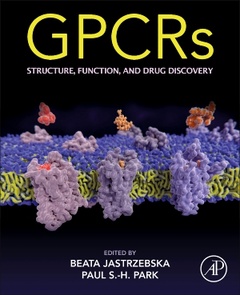Description
GPCRs
Structure, Function, and Drug Discovery
Coordinators: Jastrzebska Beata, Park Paul S.-H.
Language: English
Subjects for GPCRs:
Keywords
G protein-coupled receptors; GPCRs Structure and Activation; GPCRs; GPCR; helical receptors; GPCR structure; Single domain antibodies; GPCR structural diversity; ligand recognition GPCR activation; Structural water network; GPCR Signaling; partner protein complexes; GPCR-G protein recognition; GPCR-G protein complex; CryoEM; GPCR-arrestin complex; GPCR-GRK complex Multimeric organization; GPCRs in biological membranes; Visual receptors; Dopamine receptor; Muscarinic receptor; Serotonin receptor; GPCR heterodimers Spatial inhomogeneity; GPCR dimers; Allosteric Modulation biased Agonism; rotease-activated receptors (PAR); P2Y1 receptor Adenosine; fatty acid receptors ositive allos; opioid receptors; light activated positive allosteric modulators; &; nbsp; Non-canonical signaling; GPCR-arrestin mediated signaling; GPCR-arrestin biased signaling; retinal degenerative diseases; Alzheimer disease; Purinergic receptors; Parkinson’s disease; tumor progression; breast cancer therapy; Divers activation; type 2 diabetes diabetic nephropathy; GPCR ligands GPCR de-orphanization; orphan GPCRs; GPCR-CoINPocket; neuronal orphan GPCRs; regulation of G protein signaling; food-related disorders
500 p. · 21.4x27.6 cm · Paperback
Description
/li>Contents
/li>Readership
/li>Biography
/li>Comment
/li>
GPCRS: Structure, Function, and Drug Discovery provides a comprehensive overview of recent discoveries and our current understanding of GPCR structure, signaling, physiology, pharmacology and methods of study. In addition to the fundamental aspects of GPCR function and dynamics, international experts discuss crystal structures, GPCR complexes with partner proteins, GPCR allosteric modulation, biased signaling through protein partners, deorphanization of GPCRs, and novel GPCR-targeting ligands that could lead to the development of new therapeutics against human diseases. GPCR association with, and possible therapeutic pathways for, retinal degenerative diseases, Alzheimer?s disease, Parkinson?s disease, cancer and diabetic nephropathy, among other illnesses, are examined in-depth.
Part I GPCR structure 1. Progress in GPCR structure Determination 2. Structure, function and therapeutic potential of adhesion GPCRs 3. Structural diversity in ligand recognition by GPCRs 4. NMR-based approaches to the study of GPCRs and GPCR-ligand interactions 5. Supramolecular structure of opsins 6. Molecular determinants of GPCR oligomerization 7. Structure of G-protein-coupled receptor heteromers 8. Class A GPCR oligomerization: reasons of controversy
Part II GPCR function 9. Quantifying GPCR allostery and biased signaling 10. Kinetics of ligand binding and signaling 11. Allosteric modulators targeting GPCRs 12. Arrestin-mediated signaling at GPCRs 13. Organellar Gb? signaling - GPCR signaling beyond the cell surface
Part III GPCRs in disease and targeted drug discovery 14. G protein-coupled receptor allosteric modulators: understanding modulator affinity and pharmacological dose 15. Computer-aided GPCR drug discovery 16. Tackling the complexities of orphan GPCR ligand discovery with rationally assisted approaches 17. G protein-coupled receptors in neurodegenerative diseases 18. GPCR targets in type 2 diabetes 19. GPCRs in thromboinflammation and hemostasis 20. Angiotensin II receptors: structure-function and drug discovery 21. GPCRs in innate and adaptive immune responses 22. Role of GPCRs in cancer
Active researchers and students in biochemistry, molecular biology, pharmaceutical science, applied microbiology, and biotechnology; structural biologists, biophysicists; medical chemists; clinician scientists; specialists working in drug development in major health disciplines (cardiology, metabolic disorders, ophthalmology, oncology, neurology, immunology)
Dr. Park is an Associate Professor at the Department of Ophthalmology and Visual Sciences,
Case Western Reserve University, Ohio. He serves as Principle Investigator at the Park Lab, which focuses on molecular mechanisms underlying phototransduction and the determinants of photoreceptor cell health in the retina. Dr. Park and his team use advanced microscopy and spectroscopy methods in combination with more traditional biochemistry, microscopy, and cell biology methods. Dr. Park has published his research widely in peer reviewed journals, including Biochemistry, the Journal of Biological Chemistry, the Journal of Cell Biology, the Journal of Molecular Biology, and the European Journal of Pharmacology
- Addresses our current understanding and novel advances in the GPCR field, directing readers towards recent finding of key significance for translational medicine
- Combines a thorough discussion of structure and function of GPCRs with disease association and drug discovery
- Features chapter contributions from international experts in GPCR structure, signaling, physiology and pharmacology
These books may interest you

GPCR Signaling in Cancer 143.27 €

G Protein-Coupled Receptors, Part B 171.65 €


